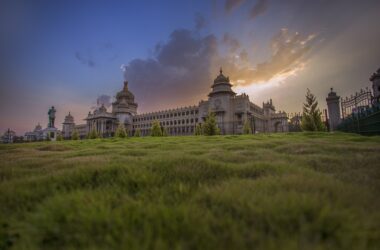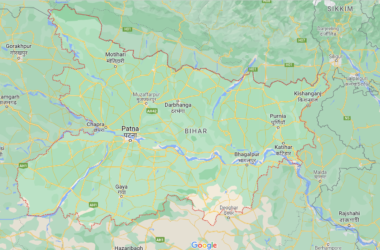Victorian Gothic and Art Deco Ensemble of Mumbai – The 19th century Victorian Gothic and 20th century Art Deco ensembles of Mumbai were inscribed on the UNESCO World Heritage Site list in 2018. About 94 buildings stand by the sea and are connected by the Oval Maidan, a historic open space. Some of the popular buildings include Old Secretariat (1857–74), Bombay High Court (1878), University Library and Convention Hall (1874–78), David Sassoon Library (1870), Public Works Department Office (1872). Watson Hotel (1869), Elphinstone College (1888), etc.
- The Ensemble includes two architectural styles – a collection of 19th-century Victorian structures and 20th-century Art Deco buildings by the sea, which are attached to the historic open space of the Oval Grounds.
- This architectural ensemble represents the world’s most remarkable collection of Victorian and Art Deco buildings that make up the unique character of this urban setting unique in the world.
- Victorian buildings from the 19th century are part of the larger fort area to the east of the Oval Grounds.
- These public buildings include Old Secretariat (1857–74), University Library and Convention Hall (1874–78), Bombay High Court (1878), Public Works Department Office (1872), Watson Hotel (1869), David Sassoon. Library (1870), Elphinstone College (1888), etc.
- The Art Deco style buildings to the west of the Oval grounds were built on the new land of Marine Drive in the early 20th century and symbolize a change in expression to represent contemporary aspirations.
This makes Mumbai the second city in India after Ahmedabad to be inscribed on the World Heritage List. In the last 5 years alone, India has been able to inscribe seven of its properties/sites on the UNESCO World Heritage List. India now has a total of 37 World Heritage Inscriptions of which 29 are cultural, 07 natural and 01 mixed sites. While India ranks second only to China in terms of the number of World Heritage properties in the ASPAC (Asia and Pacific) region, it is ranked sixth overall in the world.
The Ensemble includes two architectural styles, a 19th-century collection of Victorian structures and 20th-century Art Deco buildings by the sea, linked through the historic open space of the Oval Grounds. Together, this architectural ensemble represents the most remarkable collection of Victorian and Art Deco buildings in the world that form the unique character of this urban setting, unparalleled in the world.
The Ensemble consists of 94 buildings mainly from 19th-century Victorian Gothic Revival and early 20th-century Art Deco style architecture with an oval ground in the center. Victorian buildings from the 19th century form part of the precincts of the larger fort to the east of the Oval Grounds. These public buildings include Old Secretariat (1857–74), University Library and Convention Hall (1874–78), Bombay High Court (1878), Public Works Department Office (1872), Watson Hotel (1869), David Sassoon Library. (1870), Elphinstone College (1888), etc. The Art Deco style buildings to the west of the Oval Grounds were built in the early 20th century on newly reclaimed land on Marine Drive and symbolize a change in expression to represent contemporary aspirations.
The inscription has been done under criteria (ii) and (iv) as defined in the operational guidelines of UNESCO. Criterion (ii) refers to the significant exchange of human values on the development of architecture, monumental art, town planning and landscape, while criterion (iv) is a classic example of a type of building, architectural or technological. An ensemble or landscape that represents an important stage(s) in human history. This achievement is particularly noteworthy from the point of view of successive inscriptions of another Indian city after Ahmedabad.
Read about more heritage site
- Nalanda University : An Ancient Seat of Learning
- Great Himalayan National Park – What You Should Know
- RANI KI VAV – WHERE EVERY STEP TELLS A STORY
- Hill Forts of Rajasthan – Symbolizing Glory Of Past
- Red Fort : Explore The History Of The Mughal Dynasty
- Jantar Mantar, Jaipur – The World’s Largest Sundial
- Champaner & Pavagadh – Archaeological Park
Frequently Asked Questions Victorian Gothic and Art Deco Ensemble of Mumbai
Q. Where is Victorian Gothic?
A – To the east of the oval are Victorian Gothic public buildings and to the west are the Art Deco buildings of Backbay Reclamation and Marine Drive.
Q. How many World Heritage Sites are there in India?
A – At present, 38 World Heritage Sites are located in India. India has the sixth largest number of sites in the world.
Q. What is Victorian Gothic?
A – An architectural style belonging to the post-Gothic revival of Victoria’s reign and a combination of French, Italian and English elements with the free use of parti-colored materials.
Q. What do you understand by Gothic?
A – The adjective gothic describes something that is characterized by mystery, horror, and gloom – especially in literature. Gothic can also describe something barbaric, uncivilized and unpolished as from medieval times. This use of the word is usually capitalized.
Q. Is Gothic a religion?
A – Gothic Christianity refers to the Christianity of the Goths and sometimes the Gepids, Vandals and Burgundians, who may have used translations of the Bible into the Gothic language and shared common principles and practices.
Q. What are gothic elements?
A – The most common subject elements of Gothic literature include: Mysteries – plot lines surrounding mysterious events, disappearances, unexplained events and sinister objects. Panic and fear – doors are suddenly closed, dogs bark, footsteps, moans and terrifying sounds are heard.








